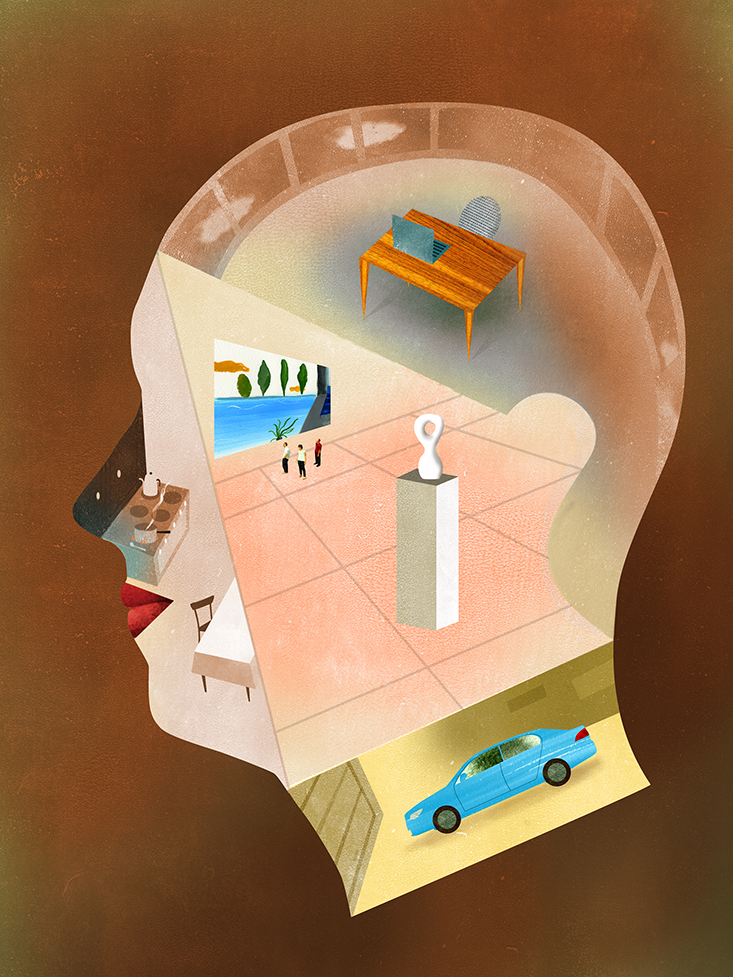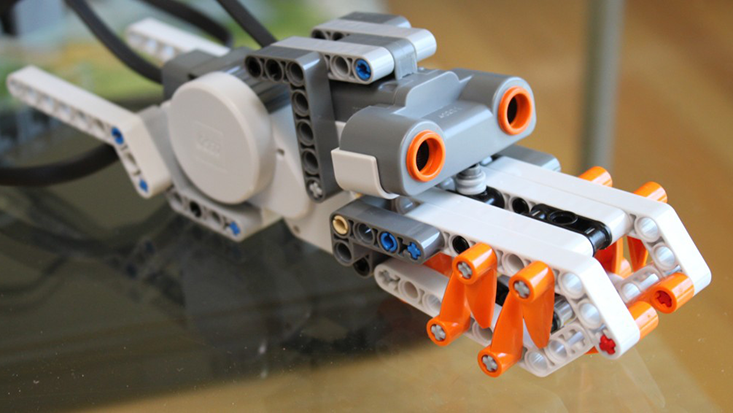Home is more than a place on a map. It evokes a particular set of feelings, and a sense of safety and belonging. Location, memories, and emotions are intertwined within those walls. Over the past few decades, this sentiment has gained solid scientific grounding. And earlier this year, researchers identified some of the cells that help encode our multifaceted homes in the human brain.
In the early 1970s, neuroscientist John O’Keefe of University College London and his colleagues began to uncover the brain mechanisms responsible for navigating space. They monitored the electrical activity of neurons within a part of the brain called the hippocampus. As the animals moved around an enclosure with electrodes implanted in their hippocampus, specific neurons fired in response to particular locations.1 These neurons, which came to be known as place cells, each had a unique “place field” where it fired: For example, neuron A might be active when the rat was in the far right corner, near the edge of the enclosure, while neuron B fired when the rat was in the opposite corner.
Since then, further experiments have shown that the hippocampus contains at least two other types of brain cells involved in navigation. Grid cells fire periodically as an animal traverses a space, and head direction cells fire when the animal faces a certain direction.2,3 Together, place cells, grid cells, and head direction cells form the brain’s GPS, mapping the space around an animal and its location within it.

Neuroscientists assumed that these three types of cells in the hippocampus are how we humans, too, navigate our surroundings. But solid evidence of these cell types came only recently, when a research team implanted electrodes into the brains of epilepsy patients being evaluated before surgery. They measured the activity of neurons in the hippocampus while the patients navigated a computer-generated environment, and found that some of the cells fired at regular intervals, as grid cells in rodents did. The authors of the study, published last August, conclude that the mechanisms of spatial navigation in mice and humans are likely the same.4
The hippocampus does more than find places; it also stores and creates memories. Matt Wilson, a neuroscientist at the Massachusetts Institute of Technology, has found that navigation and memory are woven together in rats’ brains. Place cells not only tell the rat when it’s home, but also contribute to the neuronal networks responsible for encoding the memories of what happens there. So when a scent, sound, or scene triggers a recollection of home, place cells also fire.
This means that a sense of place may be evoked by an activity as much as by a physical location, and that what you do in a place affects the way you think about it. “If an animal does something different in the same place, different place cells fire,” Wilson explains. “Essentially, you can change their maps and their sense of place, by simply changing what they do in that space.” It’s likely that the human mind operates the same way, he adds—meaning that home truly might be wherever you lay your hat. To take an everyday example, your kitchen is your kitchen because you cook in it, not just because it contains a fridge or a sink. Cooking in the kitchen helps distinguish it from your living room, Wilson says. “The fact that you do different things in them is what establishes this sense of place,” he says. “Cooking is what makes your kitchen the place that it is.”
Emotional memory also defines the boundaries of our idea of home, particularly emotions related to fear and safety. In recent experiments, Jeansok Kim of the University of Washington in Seattle and his colleagues used a robotic predator dubbed the Robogator to frighten rats into changing their perceptions of the world around them. Whenever a rat would venture out from its nest to forage for food, this mechanized nightmare lunged toward it, sending it scurrying back for the safety of home.

The terrifying experience dramatically altered the activity of the animals’ place cells, Kim reported in November at the Society for Neuroscience meeting in San Diego. Electrical recordings in the hippocampus showed that a consistent set of place cells fired when the rats were in their nest, however, those outside of the nest, near Robogator, began to fire erratically. Place cells were not only mapping location, it seemed, but also the emotional content of space. The researchers suggest that the rodents perceive the area between where their place cells fire normally and abnormally, as a boundary between safety and danger. Once the animal crosses the boundary, the brain issues a warning: You have left home and are facing danger. “For most people, home is a familiar and safe place, a very important one that they go back to again and again,” says neuroscientist Hugo Spiers of University College London.
Spiers and his collaborators found that structural alterations shift concepts of home. They recorded the activity of rats’ place cells while the animals negotiated an environment with four identical compartments. The researchers then removed one or more compartments—the experimental equivalent of ripping out a room or two to create an open-plan living space. In response, they saw a completely new pattern of place cell firing, showing that the rats had completely scrapped their old mental maps and rebuilt new ones from scratch.
Place cells were not only mapping location, it seemed, but also the emotional content of space.
People experiencing a recent renovation may undergo a similar process. “If you knock out a wall to make an open plan apartment,” Spiers says, “your map of that space will completely reorganize, and your brain will think it’s an entirely new one.” The result, he adds, may be why some people feel disoriented after remodelling their homes. It may be why studies find that people forget more information when they pass through a doorway into another room, than when they stay in the same locale.5
Understanding the details of how we meld memory and space may help architects design better houses. For example, Wilson has shown that memories of places consist of sequences of connected locations rather than isolated spaces. The use of barriers to create separate spaces inside a house may therefore lead to a different conception of the place. Although the idea has only recently gained hard empirical proof, it has long been influential in architecture. The architect Louis Kahn designed the Salk Institute in California in a way that he believed would enhance the creativity of its occupants. Taking inspiration from the 13th century Monastery of St. Francis of Assisi in Croatia, Kahn envisioned a scientific sanctuary, and designed the Institute with glass windows and big, open spaces, to create an environment that was ripe for contemplation, learning, and teaching.
Research done since O’Keefe’s initial discovery of place cells has yielded important insights into the mechanisms of spatial navigation and memory formation, but many questions remain. Neuroscientists are now studying which characteristics of home and other locations place cells respond to most strongly; how place cells, grid cells, and head direction cells cooperate during navigation; and how these networks form memories of the place that we call home. What is known, however, is something that we intuitively understand to be true: Home is a state of mind.
Moheb Costandi is a freelance neuroscience writer based in London. He is author of 50 Human Brain Ideas You Really Need to Know, published by Quercus, and writes the Neurophilosophy blog hosted by The Guardian.
References
1. O’Keefe, J. and Dostrovsky, J. The hippocampus as a spatial map. Preliminary evidence from unit activity in the freely-moving rat. Brain Research 34 171-175 (1971).
2. Hafting, T., Fyhn, M., Molden, S., Moser, M., Moser, E. Microstructure of a spatial map in the entorhinal cortex. Nature 436 801-806 (2005).
3. Taube, J. S., Muller, R. U., Ranck, J.B. Head-direction cells recorded from the postsubiculum in freely moving rats. I. Description and quantitative analysis. The Journal of Neuroscience 10 420-435 (1990).
4. Jacobs, J., et al Direct recordings of grid-like neuronal activity in human spatial navigation. Nature Neuroscience 16 1188-1190 (2013).
5. Radvansky, G. A., Krawietz, S. A., Tamplin, A. K. Walking through doorways causes forgetting: Further explorations. The Quarterly Journal of Experimental Psychology 64 1632-1645 (2011).






























